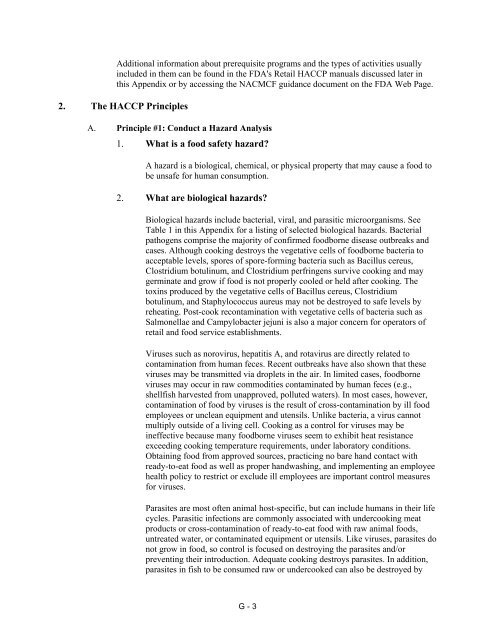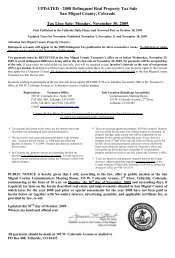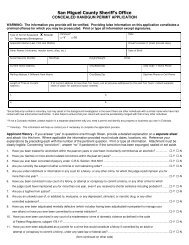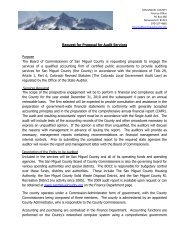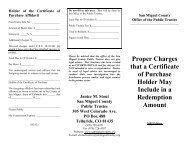colorado retail food establishment rules and ... - Boulder County
colorado retail food establishment rules and ... - Boulder County
colorado retail food establishment rules and ... - Boulder County
Create successful ePaper yourself
Turn your PDF publications into a flip-book with our unique Google optimized e-Paper software.
Additional information about prerequisite programs <strong>and</strong> the types of activities usually<br />
included in them can be found in the FDA's Retail HACCP manuals discussed later in<br />
this Appendix or by accessing the NACMCF guidance document on the FDA Web Page.<br />
2. The HACCP Principles<br />
A. Principle #1: Conduct a Hazard Analysis<br />
1. What is a <strong>food</strong> safety hazard?<br />
A hazard is a biological, chemical, or physical property that may cause a <strong>food</strong> to<br />
be unsafe for human consumption.<br />
2. What are biological hazards?<br />
Biological hazards include bacterial, viral, <strong>and</strong> parasitic microorganisms. See<br />
Table 1 in this Appendix for a listing of selected biological hazards. Bacterial<br />
pathogens comprise the majority of confirmed <strong>food</strong>borne disease outbreaks <strong>and</strong><br />
cases. Although cooking destroys the vegetative cells of <strong>food</strong>borne bacteria to<br />
acceptable levels, spores of spore-forming bacteria such as Bacillus cereus,<br />
Clostridium botulinum, <strong>and</strong> Clostridium perfringens survive cooking <strong>and</strong> may<br />
germinate <strong>and</strong> grow if <strong>food</strong> is not properly cooled or held after cooking. The<br />
toxins produced by the vegetative cells of Bacillus cereus, Clostridium<br />
botulinum, <strong>and</strong> Staphylococcus aureus may not be destroyed to safe levels by<br />
reheating. Post-cook recontamination with vegetative cells of bacteria such as<br />
Salmonellae <strong>and</strong> Campylobacter jejuni is also a major concern for operators of<br />
<strong>retail</strong> <strong>and</strong> <strong>food</strong> service <strong>establishment</strong>s.<br />
Viruses such as norovirus, hepatitis A, <strong>and</strong> rotavirus are directly related to<br />
contamination from human feces. Recent outbreaks have also shown that these<br />
viruses may be transmitted via droplets in the air. In limited cases, <strong>food</strong>borne<br />
viruses may occur in raw commodities contaminated by human feces (e.g.,<br />
shellfish harvested from unapproved, polluted waters). In most cases, however,<br />
contamination of <strong>food</strong> by viruses is the result of cross-contamination by ill <strong>food</strong><br />
employees or unclean equipment <strong>and</strong> utensils. Unlike bacteria, a virus cannot<br />
multiply outside of a living cell. Cooking as a control for viruses may be<br />
ineffective because many <strong>food</strong>borne viruses seem to exhibit heat resistance<br />
exceeding cooking temperature requirements, under laboratory conditions.<br />
Obtaining <strong>food</strong> from approved sources, practicing no bare h<strong>and</strong> contact with<br />
ready-to-eat <strong>food</strong> as well as proper h<strong>and</strong>washing, <strong>and</strong> implementing an employee<br />
health policy to restrict or exclude ill employees are important control measures<br />
for viruses.<br />
Parasites are most often animal host-specific, but can include humans in their life<br />
cycles. Parasitic infections are commonly associated with undercooking meat<br />
products or cross-contamination of ready-to-eat <strong>food</strong> with raw animal <strong>food</strong>s,<br />
untreated water, or contaminated equipment or utensils. Like viruses, parasites do<br />
not grow in <strong>food</strong>, so control is focused on destroying the parasites <strong>and</strong>/or<br />
preventing their introduction. Adequate cooking destroys parasites. In addition,<br />
parasites in fish to be consumed raw or undercooked can also be destroyed by<br />
G - 3


